|
The Slim Jim first appeared around 1906. This white introductory box is among only a handful that have turned up. The Slim Jim, like the Worden Bucktail above, was named for one of Shakespeare's fishing companions: James "Slim Jim" Heddon, whose very important lures are discussed elsewhere on this site. What a small world it must have been in 1900! |
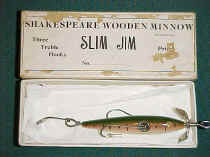 |
|
The earliest Wooden Minnows were sold in wonderful maroon, white or brown picture boxes. This example dates to around 1908. Unfortunately, the box is supposed to have a Perch Scale minnow inside, but I guess this pretty red and yellow example will have to suffice until we find the correct lure. All Shakespeare picture boxes are hard to find in any condition. |
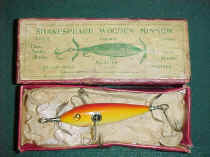 |
Like many early companies, Shakespeare was predatory, and often bought or acquired other makers' products. The McCormic Mermaid, introduced in 1912 in Shakespeare's home town of Kalamazoo, Mich., was gobbled up - and added to the Shakespeare line. This is a very rare Shakespeare picture box for this lure, which I believe was made one year - in 1914 or 1915. Two of these boxes are known to exist. You wont see these boxes often. |
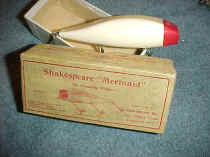 |
|
Just as the Rhodes minnows were Shakespeare's cheap line of baits around 1905, the Jim Dandy lures of the early 1930s were billed as effective but cheap wooden lures. This is the intro Jim Dandy box with a Spoonbill Wobbler inside. The color scheme is similar to typical Shakespeare boxes, but the verbage accentuates the Jim Dandy logo. |
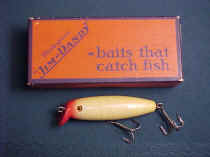 |
|
This Little Joe, also called "Injun Joe," is in its correct box, circa 1930s. This box style is the company's most common, but the paper flyer shown inside the box is somewhat scarce. Shakespeare quit making glass eyed baits in the 1930s in favor of the cheaper, but more durable, pressed eyes. |
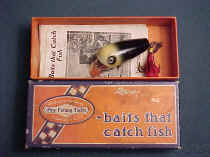 |
|
This Swimming Mouse is near mint in its correct, circa 1920s orange box, complete with matching orange Shakespeare tissue in the box bottom. The Mouse box is marked 578 BW Swimming Mouse on the endflaps, and the mouse itself is marked, in pen, 578 BW on one side of its head. |
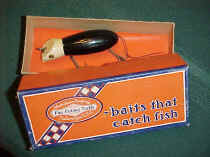 |
The John Inglis Co. of Toronto, Canada, made lures for Shakespeare at some point in the late 40s or early 50s. This redback Slim Jim with Shakespeare's patented "photo finish" scale pattern is in the hard-to-find Inglis box. Note the Inglis/Canada logo on the boxtop. This beautiful lure has the later pressed, painted eyes, and was sent to us by a police detective from Alberta who found it inside an old boat. |
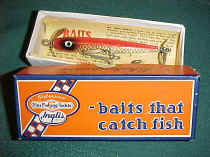 |
|
T. Robb was another fishing contemporary of Shakespeare, and the namesake of this rather elaborate "casting fly" which is actually larger than many wooden plugs. The T. Robb came in its own special box, which was short-lived in the company's long production of spoons and metal baits. |
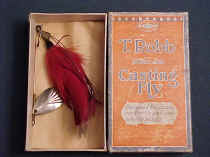 |
|
Here is another, perhaps earlier, version of the famous T. Robb Casting Fly. These white boxes with green lettering seem to be a little scarcer than the one pictured above, but there is no shortage of T. Robb lures. I'm guessing this box was made sometime in the early 1920s. The feather, according to the box, is genuine red ibis. |
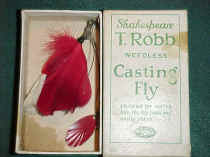 |
|
The gray box with the oval-shaped greenish logo was used in the late teens and early 1920s. They tend to fade and are hard to find in nice shape. The five-hook minnow inside has traditional Shakespeare see-through plate hardware and yellow hand painted gill marks in the chin. |
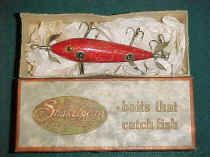 |